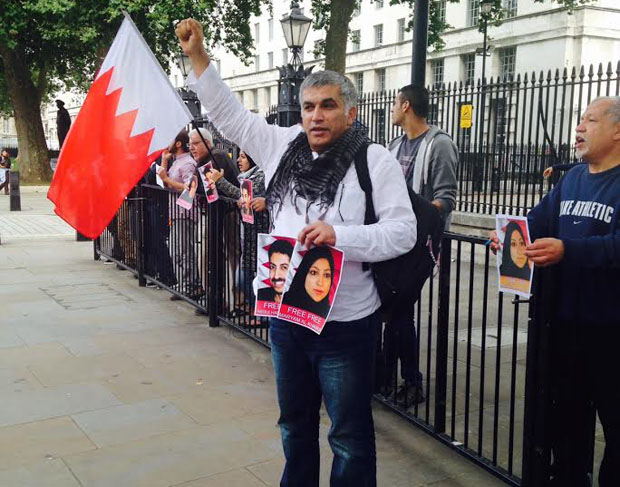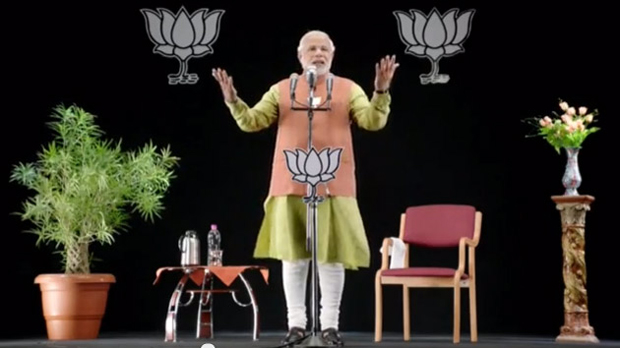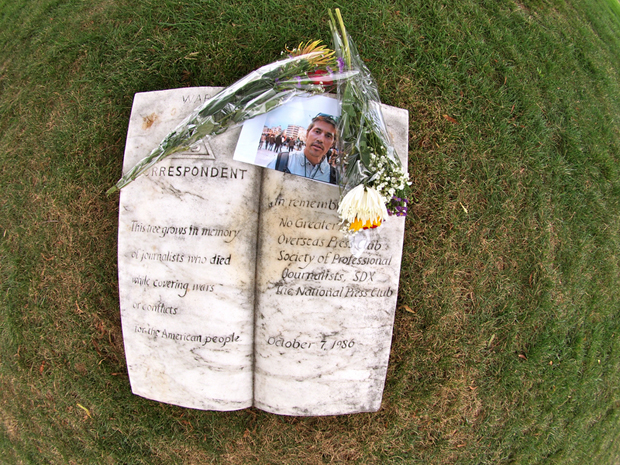20 Oct 2014 | Bahrain, Middle East and North Africa, News and features

Nabeel Rajab during a protest in London in September (Photo: Milana Knezevic)
Jailed Bahraini human rights defender Nabeel Rajab has been denied bail and his hearing has been adjourned until 29 November. The decision came on 19 October, the opening day of his trial. Rajab, a well-known activist who has played a prominent part in Bahrain’s pro-democracy movement, is facing charges of insulting government institutions through the following tweet:
According to his Twitter account, which has been run by an associate since Rajab’s arrest on 1 October, Sunday’s court session was “monitored” by representatives from “at least nine embassies“, including the US, UK and France. Family members were denied entry to the courtroom. Rajab, president of the Bahrain Centre for Human Rights (BCHR), a 2012 Index Freedom of Expression Award winner, and director of the Gulf Centre for Human Rights (GCHR), was released in May after two years in prison on charges including sending offensive tweets and taking part in illegal protests.
While in London in September, Rajab told Index about the human rights and free speech situation in Bahrain, saying that “at least 50,000 people” had been in and out of jail in the past three months alone, “just for practising their right to freedom of assembly, freedom of gathering, freedom of expression”.
Index has joined eight other organisations in asking the UK to speak out on the imprisonment of Rajab and other activists in Bahrain. The Norwegian government has called on Bahraini authorities to close the case against Rajab, while US Ambassador to the UN Samantha Power has also called for his release.
This article was originally posted on 20 October at indexoncensorship.org
3 Oct 2014 | Bahrain, Bahrain Statements, Middle East and North Africa, News and features

Nabeel Rajab during a protest in London in September (Photo: Milana Knezevic)
Nabeel Rajab, a prominent Bahraini human rights activist and Index award winner, has been detained for seven days while being investigated for claims that he offended the Ministry of Interior over Twitter.
Index CEO Jodie Ginsberg said: “Index is deeply concerned that the UK government has done little to press Bahrain to improve its human rights record. Instead the UK talks repeatedly of improvements in the human rights system in Bahrain when it is clear that rights such as freedom of expression are not being respected.” Index is writing to UK MPs to raise the case of Rajab.
On 1 October, Rajab, president of the Bahrain Centre for Human Rights (BCHR) and director of the Gulf Centre for Human Right (GCHR), was summoned by the cyber crimes unit of the Criminal Investigation Directorate. He is alleged to have “denigrated government institutions” on Twitter, according to the Ministry of Interior. Rajab was released in May after two years in prison on charges including making offensive tweets and taking part in illegal protests.
Rajab “has been targeted with repeated arrest and detention because of his work in the field of human rights” and “the government’s aim is to hinder his advocacy work both inside and outside of Bahrain”, said BCHR, Americans for Democracy and Human Rights in Bahrain (ADHRB) and the Bahrain Institute for Rights and Democracy (BIRD).
The arrest came shortly after Rajab’s return to Bahrain following an international trip to raise awareness of human rights violations in his country. He was calling for the release of human rights activists — and father and daughter — Maryam and Abdulhadi Al-Khawaja. Maryam has since been released on bail, her travel ban lifted and trial postponed until 5 November. Abdulhadi continues to serve the life sentence handed down to him in 2011, after playing a prominent role in the country’s pro-democracy protests that year.
While in London, Rajab told Index about the human rights and free speech situation in Bahrain, saying that “at least 50,000 people” had been in and out of jail in the past three months alone, “just for practising their right to freedom of assembly, freedom of gathering, freedom of expression”.
“It is time for Bahrain’s rulers to stop harassing human rights defenders and silencing free speech, and live up to their international obligations – including those they pledged again to uphold as part of the UN Universal Periodic Review just last month. Please, let our colleagues go free. Free Nabeel Rajab and drop the charges facing Rajab and the Al-Khawajas, ” GCHR said in a statement.
Correction 10:30, 3 October: Due to a typo, an earlier version of this article used the number “50,0000” instead of “50,000”.
This article was posted on 2 October 2014 at indexoncensorship.org
27 Aug 2014 | Asia and Pacific, India, News and features

While campaigning to become prime minister, Narendra Modi addressed voters through 3D technology on several occasions (Photo: Narendramodiofficial/Flickr/Creative Commons)
Indians don’t usually take much notice of the prime minister’ speech on independence day in the middle of August. This year was different. This year there was so much discussion on social media that it became a trending topic.
In contrast to the way other prime ministers have handled this moment, new Prime Minister Narendra Modi of the Bharatiya Janata Party (BJP), wowed a large section of Indian society not just with what he said, but the way he said it. People are gushing over the fact that he spoke without notes, and did not use the usual bulletproof glass. Others are impressed with the content; he touched upon topics as diverse as rape, sanitation, manufacturing, and nation building, using easily accessible language. Modi is also using social media to get his views across direct to the public, and bypassing the mainstream media.
This straight-talking style only adds to Modi’s brand, but he is also attracting criticism from the mainstream media for not being willing to answer hard questions. His chosen methods of communicating with the public have one common thread: he prefers to address the public directly, plainly, without going through the mainstream media or any reliance on further explanation by them. His social media accounts on Facebook and Twitter have completely changed the way information comes out of the prime minister’s office (PMO). Modi’s tweets, both from his personal and his prime ministerial account, keep citizens updated on his various trips (“PM will travel to Jharkhand tomorrow. Here are the details of his visit”). He also updates on his musings (“I am deeply saddened to know about Yogacharya BKS Iyengar’s demise & offer my condolences to his followers all over the world”) and highlights from speeches made across the country (“when the road network increases the avenues of development increase too”), as well as photographs and videos. Citizens are getting a front row seat at his speeches and thoughts. But not everybody is happy about this — especially not the private mainstream media.
Unlike the previous government, Modi is yet to appoint a press advisor. That person, normally chosen from senior journalists in New Delhi, advises the prime minister on media policy. There isn’t a point person from the PMO for the mainstream media — or the MSM, as it is called — to discuss stories and scoops. He only takes journalists from the public broadcasting arms — radio and TV — on his foreign trips, in contrast to his predecessor, who brought along more than 30 journalists from the public and private channels. In fact, Modi has reportedly instructed his MPs to refrain from speaking to journalists. Indian mainstream media is filled with complaints that Modi is denying journalists the opportunity to engage with complex subjects like governance beyond official statements and limited briefings. Meanwhile, some other publications have scoffed that the mainstream media is only complaining because it will be forced to analyse the news and work towards coherent reporting instead of relying of well honed cosy relationships with people in power.
This apparent rift between the PMO and the private mainstream media has to be viewed through a variety of prisms for it to make any sense. The first is the very volatile relationship between Modi and the MSM which harks back to his time as chief minister of Gujarat, when a brutal communal riot took place. The second is the state of the mainstream media itself, continuously called out for unethical practices by the likes of the Telecom Regulatory Authority of India.
The relationship between Modi and the mainstream media is complex. No court has indicted Modi for any criminal culpability in the Gujarat riots of 2002, but many in the media have held him morally responsibly for the mass killings that carried on over three days, and let their feelings colour reports on him. But right before Modi’s historic sweep of the Indian general elections, this section of the press seemed to have begrudgingly warmed to the man they had long vilified.
One of India’s most respected journals, Economic and Political Weekly, published the article Mainstreaming Modi, deconstructing this new wave of coverage. It argued that the reasons for this change “range from how even the United Kingdom and the European Union have ‘normalised’ relations with him [Modi], that he has been elected thrice in a row to the chief ministership of Gujarat, which surely speaks of his abilities as an ‘efficient’ and ‘able’ administrator, that Gujarat has become corporate India’s favourite investment destination, and most importantly, that he is the guy who can take ‘decisions’ and not keep the nation waiting for action.”
During this year’s election campaign, Modi’s use of the media was innovative. Stump speeches were tailor made for the towns he was campaigning in. Modi’s 3D holograms, deployed in small towns while gave a speech elsewhere, were a spectacle not seen before in India. Though Modi had been speaking to Hindi and other Indian language media, he delayed giving interviews to the English language “elite” media, watched by a small but influential section of the population. He finally consented to doing a one-on-one interview with Arnab Goswami of Times Now, known as one of India’s loudest and most aggressive anchors. People readied themselves for the ultimate combative hour on television, but Modi’s no-nonsense answers, it seemed, won over both the anchor and the audience — especially as they were in sharp contrast to the vague statements put across by Modi’s challenger, Indian National Congress Party candidate Rahul Gandhi.
After the election win, India’s mainstream media has been forced to reassess what it wants from the prime minister. Is it information or is it access? The mainstream media undoubtedly has had a very complicated and close history with the political class. A Congress-led government has been ruling New Delhi for a decade, building up close relationships with senior editors and journalists. Some of these relationships were exposed through leaked conversations between members of the press and corporate lobbyists in a scandal now known as the Radia Tapes. They revealed, among other things, how journalists used their connections to politicians to pass on messages from lobbyists.
In fact, the indictment of improper behaviour by the media is a fairly regular occurrence in India. Just this month, the Telecom Regulatory Authority of India released their latest report, which recommends that corporate and political influence over the media can be limited by restricting their direct ownership in the sector. For this reason, the credibility and true affiliation of the media is always under the scanner.
But Modi and his team also need to respond to questions about why they will not deal with some parts of the media. How do they view the role of a combative media? Is only the public broadcaster, which reports the story as the government wants, to be allowed access? Are critical questions being avoided?
Perhaps, the last word can go to Scroll.in, one of India’s newest online magazines: “[T]he rat race for the ego scoop undermines the most important scoop, the thought scoop. We often don’t look at the big picture, don’t take the long view, don’t see the obvious, forget the past, don’t study the boring reports, substitute access journalism for ground reporting, believe the official word. Narendra Modi might just be doing us a favour by keeping us away.”
This article was posted on August 27, 2014 at indexoncensorship.org
21 Aug 2014 | Digital Freedom, Digital Freedom Statements, News and features, Uncategorized

Tributes to James Foley were placed at the War Correspondents Memorial in Arlington National Cemetery (Photo: Cynthia Rucker/Demotix)
On Thursday, after a video emerged of U.S. photojournalist James Foley being beheaded by Islamic State (ISIS) militants, the Metropolitan Police in London suggested that anyone who watched the video could be committing a crime. This takes us well beyond the realms of the #ISISmediablackout being urged by social media users, many of them journalists themselves, and does go to the heart of why censorship of such material is deeply problematic.
Questions of free speech and free expression are rarely clear-cut: the human rights laid out in the Universal Declaration frequently grate up against one another. Balancing the right to a privacy, for example, with the right to free expression and the public‚s right to know can be a high wire act; as is the balance between protecting children online from exposure to graphically violent or sexual content, and full-scale censorship.
And so deciding whether sharing, or even watching, a video of a criminal act, created as a deliberate piece of propaganda, rightly raises important questions. Are those disseminating this information playing into the hands of propagandists, so furthering their cause? Or are they raising awareness of their practices to a wider audience, leading to a better informed public? It is understandable that Twitter should want to respect the wishes of James Foley’s family by encouraging people not to share it. It is also understandable that Twitter and others would not want to be seen to be promoting propaganda that potentially glorifies terrorism and acts of horrific violence. It is also understandable that many social media users want to encourage an ISIS blackout, arguing that by sharing the Foley video, sharers simply give the group the oxygen of publicity and encourage more such acts.
But there is a difference between individuals exercising their right not to view or share the video, and companies such as Twitter — or indeed the police force — denying people the right to view it. If the Met police is right that just by watching the video individuals are committing a crime (and they have yet to show how or why this is), then David Cameron has broken the law. Barack Obama has also seen the video. As have I. As have a number of the journalists writing about the video in today’s papers: something they needed to do to be able to describe its full horror to others. We should not feed the flames of the propagandists by mindlessly sharing their videos, but nor should we make the mistake of assuming that global corporations, or indeed police forces, should decide who sees what. Because that simply plays into the hands of all those who want to end societies in which dissent and difference is tolerated; the kind of societies that celebrate and cherish the work of men like James Foley.
This article was posted on August 21, 2014 at indexoncensorship.org



